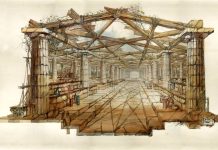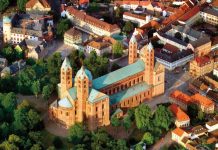In 1906, various Parisian artists individually claimed to have “discovered” important artistic attributes in African sculptural artifacts. Who made this discovery and how it came about, is less important than its influence on the development of Modern Art.
In 1937, Andre Malraux recorded a conversation with Picasso about Picasso’s 1906 discovery of African sculpture at the Trocadero Museum. Picasso said: “The masks weren’t like other kinds of sculpture. Not at all. They were magical things… the sculptures were intercessors… against everything; against unknown threatening spirits. I kept looking at the fetishes. I understood: I too am against everything. I too think that everything is unknown, is the enemy!… Les Desmoiselles d’Avignon must have come to me that day, but not at all because of the forms: but because it was my first canvas of exorcism” (Cladel, 1937).
The artists that turned to Africa and Oceania were fascinated by the exotic, the magic and the wildness that those cultures possessed. Africa and Oceania, to them, were places of fetishism and superstition, of the animalistic and the primitive. Africa and Oceania exorcised these artists from their rigid intellectualism and over-civilized culture that had cut them off from their emotional spontaneity , naturalness and “origins”. Picasso discovered in African and Oceanic sculpture new expressive potentials of the human figure, abstract ways to capture states of mind, and complete freedom to reorder the human image.
Re-evaluating the formal armature and spatial connections of objects, in 1907 Picasso and Braque discovered a system for depicting three-dimensional relationships independent of perspective. Later on, they dispensed with closed forms, and fragmented objects were combined in ambiguous and unexpected ways. These experiments produced the style known as Cubism, which revolutionized Western art for most of the 20th century.
Charles Jeanneret (Le Corbusier) and Amadee Ozenfant, through their writings and work (1916-1925), hoped to succeed Cubism in the visual arts. They thought of Cubism as too decorative and chaotic. They believed the time had come for a more rigorous style that retained the essential aspects of Cubism but had a basis in the (Eurocentric) laws of structure and composition. They called their new expression Purism. Distilling Cubism from its primitive art sources stripped the style of its rich formal tensions, emotional power, and ambiguity. The architecture that Purism influenced was therefore cold, and mechanistic. But Le Corbusier did not completely abandon the ideas of early Cubism; the influence of primitive art appeared in his work after 1930 as he reassessed his views on vernacular architecture, cultural symbols, and idiosyncratic humanity.
The Primitive in Art and Architecture
There are important differences in the way that “primitive” was understood in art and in architecture at the turn of last century.
Primitive art as we know it today, usually refers to sculptures from Africa and the South Seas, pre-Columbian art of Central and South America, and works of the American Indian and the Eskimos. The term does not include the art of early civilizations such as those of Mesopotamia, China or the Aegean, although it is stylistically similar to the modern concept of primitive art. The unifying principle of primitive artworks is animism: they were not created as “works of art” in the Western sense; they were used in magico-religio-social functions and not produced for sale (Sergy, 1969). These works are associated with fetishism, magic and mythology.
The term “primitive” began its current use in the 18th century and connoted the art of tribal or native societies most of which were associated with the European colonial expansion.
Within the artistic realm, the term exists among a whole constellation of words: savage, barbarian, exotic, aboriginal, uncivilized, naive, instinctive, archaic, native, tribal, erotic, outsider, to give but a few. The term may be condescending, tending to denigrate who or what is described by it, and implies an assumption of superiority in whoever uses it. The term may also be liberating because it assumes an authentic and spontaneous worldview, the myth of the noble savage. Primitive in art was unknown to the art theorists of the classical tradition, and was completely unlike anything that they might have conceived. This is why the influence of primitive art in early modernism was considered highly subversive and has been a controversial issue ever since.
The primitive in architecture is a less contentious concept. It is considered a source of architectural history and therefore an integral part of the profession. Primitive buildings are key points of reference, the myth of a primitive hut as the beginning of architecture has been a common historical datum since Vitruvius. Discoveries in new lands have only confirmed this theory (Odgers, Samuel and Sharr, 2006).
Connotations of primitivism in architecture are less negative than those in art; terms such as vernacular, non-pedigree, and indigenous are usually associated with the wisdom of tried and true building practices closely related to specific cultures, regions and climates.
In this respect, architecture is quite unlike other art practices, particularly painting and sculpture, where the primitive has always been used to destabilize the tradition of Western art. Gauguin’s discovery of the primitive in Tahiti, Picasso’s interest in African masks, the German Expressionist painters’ interest in African sculpture, and the surrealists’ interest in tribal imagery were all subversions of traditional values in art with no intention of affirming eternal values (Odgers, Samuel and Sharr, 2006). Instead, they intended to threaten bourgeois taste, by revealing a more direct form of expression uncontaminated by cultural over-sophistication, or to assert the presence of the irrational and the unconscious underlying art practice.
The term “primitive” is often misused and misunderstood. It is too often used synonymously with crudity, although the root of the word “primitive” means original, primary or not derived. In general, the idea of the primitive has always been to oppose prevailing norms of taste by appealing to something original, far away, and yet, at the same time near and at hand. In architecture, the principal purpose of the primitive has been, as Joseph Rykwert says, to renew architecture. “The primitive hut… has provided a point of reference for all speculation on the essentials of building. These speculations intensify when the need is felt for a renewal of architecture”(Rykwert, 1972).
Vernacular and primitive architecture has also been studied as a repository of unconscious and sustainable wisdom; it represents a moment in which humans directly related to their local environments and derived their buildings in response to local climate, materials and traditions.
Picasso and Primitive Art
Intensified contact with the colonies and the new science of anthropology opened an appetite for the exotic in 18th century Europe. Everything that was unknown at home was found fascinating; exotic nakedness for example amused Europeans constrained in corsets (Stepan, 2006). The excess of civilization at the beginning of the 20th century had Europe ready for the primitive influence. The prescription therapy was in the forms and products of pre-industrial culture and mentality. To Picasso, “primitive” meant archaic cultures including Mediterranean antiquity. It also included a new found interest in animistic art from Africa and the South Seas.
Picasso mixed his influences as he went along. References to an archaic classicism appear and reappear in his oeuvre throughout his artistic life. The assimilation of Iberian and Etruscan sculpture in his pastoral paintings of 1906, for example, paved the way for the subsequent heightening of sculptural presence under the impression of African figures and masks. The coexistence of multiple and often opposing paradigms in Picasso’s work is testimony to the enormous radius and elasticity of his corpus. Yet European “antiquity” is no more a monolithic concept than “Africa” is.
In both cultural realms, Picasso remained apart from the mainstream, exploring marginal zones and tapping into powerful sources of archaic collective imagery. Les Desmoiselles d’Avignon (1907) include these hybrid influences. Reading the five nude figures from left to right, the first three archaic-looking women are inspired by Iberian sculpture. They pose from multiple viewpoints with hypnotic eyes and defiant gestures. The last two figures have menacingly deformed faces showing both human, and African mask features. The appearance of hybrid creatures in Picasso’s pictorial cosmos remind us that metamorphoses of this kind are a specialty of archaic and indigenous cultures, particularly in Africa. Unlike antiquity, the traditions remained alive on the latter continent until well into the 20th century.
In African art Picasso found a physiognomic richness of expression in his wish to render visually, beings from other strange worlds. That is what accounts for the enigmatic ambivalence and ambiguity that is the key feature of African sculpture. Equally in contact with the worlds of man, animals, and imagined spirits, metamorphosis was and is a great specialty in Africa. African sculptural figures emphasize their constituent elements; for instance the mouth, eyes or breasts, rather than the harmony of the work as a whole. They were proportioned according to the passions that inspired them. Referring to African sculpture Maillol said that it often has the gift of combining “twenty forms into one” (Cladel, 1937).
Similarly, a solid may indicate a void, and vice versa, or a concave form may represent something that in nature is convex. Formal signs become substitutes of direct observation of nature. African sculpture provided Picasso a new combinatory logic of elements in the human figure. As Cubism progressed after 1906, Picasso together with Georges Braque began experimenting with simultaneous superimpositions of two or more abstracted and semi-transparent forms. What Paul Cezanne’s “passage” had done before by linking foreground and background, Analytical Cubism achieved by superimposing transparent forms and objects creating intersections of rich spatial ambiguity.
By 1912 Picasso and Braque had dispensed with closed forms altogether and collage in the form of Papier Colle had become almost completely abstract in a perfectly flat space. Synthetic Cubism, as this later stage is called, favored still-life collages using common household industrial objects as references. Cups, bottles, moldings, newspapers, musical instruments etc, abstracted in a pictorial space, appealed to architects because the paintings looked like plans and elevations of buildings seen from multiple perspectives. The wealth of motifs and explorations in Picasso’s work and the intense humanity that informed them can only testify to his passionate desire to portray the richness of life at an emotional, sensual and intellectual level.
Le Corbusier and Purism
Although Le Corbusier was only six years younger than Picasso and both men lived in Paris sharing acquaintances for some time, they did not develop a friendship or meaningful relationship. When Le Corbusier first came to Paris to work for Auguste Perret in 1908, Picasso and Georges Braque had already invented Cubism and were among the up and coming avant-garde painters in Europe.
The young Charles Eduard Jeanneret, (alias Le Corbusier), started to paint regularly around 1918 –working side by side with Amadee Ozenfant – his pictures showed bottles, glasses, plates, and guitars, the objects favored by the cubists. But in contrast to the cubist works of Picasso and Braque, the plastic identity of these objects was emphasized to represent a new morality, the spirit nouveau, of a machine age based on industrial types and standards. It seemed that after the debacle of the First World War, a new era of classical restraint and a new elementarism was arising in all areas of culture.
This phenomenon, according to the two founders of Purism, called for a new conception of art (Von Moss : 1980). By 1918, it was already clear that Cubism had completed the dislocation of the traditional concept of plastic space originally started by Manet. To many, it was equally evident that the succession to Cubism lay wide open; Picasso himself had moved on to search other artistic explorations. As a result, in the atmosphere of uncertainty of the immediate post-war period, the manifesto “Apres le Cubisme (1918), written by Jeanneret and Ozenfant, was to find an unexpected echo.
In it, Jeanneret and Ozenfant stressed the ethical value of the principles laid down by the initiators of Cubism. By reducing form to its geometrical, hence intelligible elements, and by re-evaluating the notion of composition, Cubism had reinvigorated painting; but the method of analysis it used had led to the splintering of form to which despite its best efforts, failed to find remedy. Even more serious to their eyes was the laxity displayed by Cubism in the application of classical constructive principles. From this they concluded that the new times demanded a spirit of exactitude of which Cubism had shown itself incapable (Besset, 1968).
Jeanneret and Ozenfant were seeking to bring about a culture and a society based on technology, purity of design, and planning in all spheres of life. As artists, their Purist paintings favored still-lifes and reduced objects to strict orthogonal composition in plan, elevation, and section combining them within a transparent collage medium. They composed this formal strictness using classical regulating lines to achieve a balanced and controlled effect. It did not seem intentional that the cubist system of space construction could be applied to fields other than that of painting.
And yet, despite the purely pictorial orientation of their preoccupations, the cubists produced important suggestions of architectural space. In the first place, the simultaneous representation of the object from several angles implied at least a virtual mobility on the part of the spectator. Transposed to the plane of the practicable space of architecture, this new mobility made it possible to break with the classical system of static, purely visual, arrangements, composed in terms of axes and symmetries, and to endeavor to reintegrate within architecture the sum total of the complex experience of movement.
By superimposing non-concordant, discontinuous images, Cubism stripped the object of its opacity and its density, rendering it at once transparent and permeable to the medium that surrounds it, and with which it then engages in interplay of unstable, shifting relations. It has long been realized that this bursting of the hitherto impenetrable outer covering of things, this reduction of the object to a transparent order, this co-penetration of interior and exterior, corresponded very closely to that simultaneity in the experience of space which modern construction had already been proposing for several decades.
Finally, by reducing the complexity of the forms of sense experience to a limited number of geometric elements, Cubism facilitated the assimilation of that formal language, shorn of all accidental detail, which was specific to modern construction (Besset, 1968). Le Corbusier was one of the first architects to make a direct connection between the Cubism-Purism pictorial techniques and architecture. The emerging relationship between artistic activity, industrial production, and a new architectural space formulated the essential themes of that “new spirit” which would soon manifest itself in architecture in the guise of what is generally termed the International Style.
Le Corbusier still-lifes in the Purist mode from 1918 to 1925 are characterized by classical precision and mundane elegance. As a Purist he strove to capture the exact cross-section and plan of the bottles, glasses and musical instruments.
According to the art critic Edward Fry, the Purist paintings of Ozenfant and Jeanneret are Cubism stripped of all its spatial and formal tensions, wit and ambiguity. It produced a sort of heretical Calvinist Cubism (Fry, 1978). The “Purist” architecture of Le Corbusier, although spatially complex, is equally reductive and a-tectonic. With few materials and textures and with white as an overall color, the general spatial experience is aseptic, industrial and cold. As a reaction of this awareness, Le Corbusier began changing his painting techniques in 1926, as a prelude to deeper changes in his architectural style and philosophy.
Picasso in the 1920s and 30s
By 1920, Picasso was the most famous vanguard artist in Paris, his work avidly pursued by European and American collectors. His life-long search for liberation made him rebel from his own creations including Cubism. As early as 1915, Picasso entertained figurative painting again. Naturalistic and abstract themes and combinations of them resurfaced on and off throughout the rest of his artistic career.
In the 1920s Picasso painted in a new objectivity vein, women with classical profiles, heavy limbs and robes like fluting on columns. It was, once again, a resurfacing of his antiquity themes.
A third comeback happened in the 1930s when the Minotaur became a key motif. His need for recollection induced him to treat the figure of the Minotaur and later the faun as an alter ego. For Picasso the Minotaur, half man, half bull was close to the toro of the Spanish bullfight, endowed with mysterious volcanic forces. His Minotaur or faun personified the sardonic “monster” with steaming nostrils flaring with excitement, circling the naked slipping girl and throwing itself wildly on her inviting, defenseless body (Stepan, 2006).
Picasso was particularly taken with depictions of hybrid creatures – beings born of humans and bulls, horses or goats, allowing him a variety of different identifications. Among the hybrids were also goat-legged, horned centaurs or a winged demon with the head of a bull-bird. By showing these creatures in their animal nature, they look all the more human. A zoomorphic, archaic antiquity conjures up a pre-rational civilization when there could be cross begettings between the realms of mankind, animals, and gods (Stepan : 2006). There is a correspondence between Picasso’s hybrid creatures in an antique vein and the polymorphism of African and Oceanic art. Minotaur and Pan have long died out in Europe but continue to live in present day African dances.
Some of the figures depicted by Picasso during this period show a sensuous curvilinearity. The figures sometimes reduced to a mere outline are overlapped creating new and unexpected figures as the web of their outlines intersect. This new mode of expression will affect Le Corbusier’s art, architecture and urbanism once again after 1930.
Le Corbusier 1930-1957
Le Corbusier’s early references to the primitive are always related to eternal and universal Eurocentric values. With Purism he devoted himself to show that geometry was the language of man and that geometric proportions were the eternal, timeless basis of architecture. Le Corbusier’s use of this genre of primitive belongs in the tradition of classical theorists of architecture.
Just like Laugier, he uses it to criticize the present abuses asserting an original model from which architecture has deviated (Odgers, Samuel and Sharr, 2006). However, these eternal values changed over time. In Une Maison un Palais (1928), Le Corbusier’s account of the origins of architecture starts off with speculative archaeological reconstructions of the primitive dwellings in Mesopotamia, then switches to Brittany, and finally to the Landes in southwest France. Le Corbusier’s description of the fishermen’s shacks in the Landes is a perfect example of how the near-at-hand becomes construed as the primitive. Le Corbusier writes with admiration about the intuitive spontaneity of the fishermen giving them a lyrical and human quality: “The fisherman, why shouldn’t he be a poet too – the savage after all is a fine one” (Le Corbusier, 1928).
It is possible to argue that the full story of the development of Cubism began settling on Le Corbusier around 1926. Some of the same values that Picasso had found in a humanist primitivism started to appear in Le Corbusier’s work. The sensual lines of female nudes emerged in his paintings after 1930, his artworks became freer, curvaceous, and with little reference to strict geometry. Animals started cropping up in his paintings, bulls, hybrid beings, and even Minotaurs. There was a delayed following of Picasso in Le Corbusier’s work. Purism arose seven years after the first Cubist experiments.
The continuous contour lines and the reference to bulls and Minotaurs appeared in Le Corbusier’s paintings long after Picasso had unleashed them. This curvaceous lines will inform some of Corbusier’s most famous urban ensembles such as the plan for Algiers of 1930 and Rio de Janeiro in 1936 . Jeanneret (Le Corbusier) and Ozenfant must have been not only very knowledgeable of Picasso’s art but also great admirers. Le Corbusier was the first owner of “Bottle of Rum”.
He bought it through Ozenfant from one of the large sales held in Paris in the early 1920s. This occurred at the high point of Le Corbusier and Ozenfant’s Purism. Ozenfant bought not only for himself and Le Corbusier, but also 12 Picassos for the major collector of Cubist and Purist paintings, Raoul La Roche. Le Corbusier designed two adjoining houses for La Roche and Le Corbusier’s relative Albert Jeanneret. The two houses are home of the Le Corbusier foundation in Paris today.
Le Corbusier’s break with the dogmatic aesthetic of Purism, coincides with the conceptual point in his career when he began to abandon his faith in the inevitability of a machine-age civilization. From now on, disillusioned by industrial reality, his style began to move in two opposite directions at once. On the one hand he returned, at least in his domestic work, to the language of the vernacular, on the other, he embraced the monumentality of Classical, not to say Beaux- Arts grandeur (Frampton, 1992).
The erotic, haptic and mythical that was denied during the Purism period, came to inform some of Le Corbuier’s later works. Several of his houses began showing vernacular construction traits of this new genre. The Maisons Jaoul were an affront to those sensibilities which had been nurtured on the myth that modern architecture should manifest itself as smooth, machine-wrought planar surfaces set within an articulated structural frame. Built by Algerian laborers equipped with ladders, hammers and nails, with the exception of glass, no synthetic materials were used (Stirling, 1991). Mythic and symbolic elements informed several of Le Corbusier’s most important works specially the church of Notre-Dame-du-Haut (1955), and the governmental complex of Chandigarh in India.
The primitive had one of its clearest expressions in Le Corbusier’s oeuvre, in a documentary that he created for the Philips Pavilion that was also designed by his firm. The film that he called Poeme Electronique contained some of the themes favored by Picasso in his paintings: bull and matador to show animal and human oppositions, classical statues representing both the mythic and the rational of the European past, and tribal sculpture to establish commonalities among cultures and link our past and our future.
Conclusion
The influence of primitive art, in all its different modalities, allowed artists at the turn of last century to break with the artistic traditions of their time. By avoiding academic composition and technique, artists were unrestricted to explore a wide variety of human themes and emotions. In a strange way, it was a tool to criticize, or an attempt to make sense of the modern industrial experience. Picasso was undoubtedly one of the most perceptive and skilled artists of his time. His artistic work was pivotal for many of last century’s artistic movements.
Equally aware was Le Corbusier’s architecture that expressed modern ideals. What connected these two individuals was their artistic pursuits. Le Corbusier saw in Cubism a new formal language that could influence the spatial organization of architecture. He used his painting as some kind of laboratory, where he could explore formal relationships free of the practicalities of construction. Le Corbusier’s paintings had a strong connection with his ideas, writings and architectural production. Le Corbusier first approached Picasso’s work from a rational point of view.
By trying to discipline and moralize Cubism, he made it accessible to a new rational organization of architectural space. Later on, Le Corbusier grew disillusioned of his own “Purist” style and the architecture associated with it. Upon re- evaluating Picasso’s art, Le Corbusier found in Picasso’s primitive influences, an emotive richness that his personal work was lacking. Le Corbusier first changed his pictorial style by introducing figuration, feminine sensuality and symbolism. He later changed his architecture by incorporating vernacular forms and materials, by exploring sensuous shapes and symbolic content, and by a heightened awareness of topography, texture, and color.
Corollary
The comparison between Cubism and Purism can be expanded to include counterparts in the context of Chinese culture. Cubism originated as escape from over-intellectualism in turn of the century Europe, and favored spontaneity and intuitive innovation. Purism on the other hand, strived for bringing modern painting within the rational ethics and formal etiquette of classical composition. A similar comparison can be made with ancestral Chinese philosophy where Taoism is an anti-literary tradition that favors intuition and naturalness, while Confucianism favors social etiquette and regulated morals.
In the context of traditional Chinese architecture, the classic Chinese garden can be said to express Taoist ideals while traditional courtyard housing such as “hutongs” likely represent Confucian cannons regulating family life and domestic space. The massive development of International Style architecture in modern Chinese cities today, calls for a re-evaluation of old Chinese ideals in which nature’s wisdom and intuition should be strongly considered as a counterpoint to oversimplified and generically regulated modern designs.



















